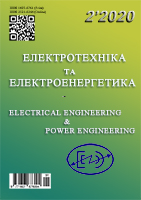Research of the non-sinusoidal loads impact on the operability of tap-changers contacts
DOI:
https://doi.org/10.15588/1607-6761-2020-2-2Keywords:
трансформаторное оборудование, резкопеременные нагрузки, устройства РПН, контактное сопротивление, несинусоидальный ток, надежностьAbstract
Purpose. To establish quantitative indicators of the influence of non-sinusoidal loads on the parameters and operability of contacts of voltage control devices of transformers of power-consuming electrical installations
Methodology. In our research, we used the probabilistic-statistical methods to analyze the experimental findings. Experimental studies were carried out applying advanced software-based methods for processing, systematizing and visualizing the findings derived.
Findings. The analysis of the accident rate of transformers for power-consuming technological installations showed that adjustable transformers, in particular, on-load tap-changers, are in many cases the cause of failure in the operation of electrical installations. On the example of a switching device of the RNOA-110/1250 type, it was experimentally established that the non-sinusoidality of the current caused by abruptly alternating loads, in combination with an increase in the number of switchings, leads to an increase in the contact resistance, which significantly reduces the reliability and serviceability of contacts.
Originality. The dependence of the transient resistance of the contacts of the voltage control device under the load of the transformer on the degree of non-sinusoidality of the load current is obtained.
Practical value. The results of the work can be used in the development of new designs of on-load tap-changers for special purpose operation under conditions of load fluctuations. In particular, the work is aimed to increase the reliability of on-load tap changers contact systems, as well as in the study of the operating conditions of network and furnace transformers in power supply systems of energy-intensive technological installations.
References
[1] Aleksandrov, G.N., Borisov, V.V., Kaplan, G.S., i dr. (2000). Teoriya elektricheskikh apparatov: Uchebnik dlya vuzov / pod red. prof. G.N. Aleksandrova. SPb. Izd-vo SPbGTU, 540.
[2] Porudominskiy, V.V. (1974). Ustroystva pereklyucheniya transformatorov pod nagruzkoy M. Energiya. 288.
[3] Vilenkin, S.Ya. (1979). Statisticheskaya obrabotka rezul'tatov issledovaniya sluchaynykh funktsiy. M. Energiya. 250.
[4] Slade, P.G. (2014). Electrical Contacts: Principles and Applications. CRC Press Taylor & Francis Group, LLC. 1257.
[5] Braunovich, M., Konchits, V.V., Myshkin, N.K. (2007). Electrical Contacts: Principles, Applications and Technology. CRC Press Taylor & Francis Group, LLC, 660.
[6] Vanin, B.V. (2001). O povrezhdeniyakh silovykh transformatorov napryazheniyem 110–500 kV v ekspluatatsii [About failures of 110–500 kV power transformers in operation]. Electric stations, 9, 53– 58, (in Russian).
[7] Zinovkin, V.V., Sisunenko, O.I., Sergiyenko, S.L., Zozulya, D.V. (1994). Nestatsionarnyye rezhimy silovykh transformatorov pri rezkoperemennoy nagruzke [Unsteady state conditions of power transformers under load fluctuation]. Energy and Electrification, 5, 48–52, (in Russian).
[8] Vlasov A.B. (2002). Raschet ekspluatatsionnykh pokazateley nadezhnosti kontaktnykh soyedineniy s pomoshch'yu teplovizionnogo kontrolya [Calculation of reliability operational performances of contact connections using thermal imaging control]. Electrical Engineering, 8, 30–35, (in Russian).
[9] Plokhov, I.V. (2004). Issledovaniye soprotivleniya styagivaniya elektricheskogo kontakta [Study of the constriction resistance of electrical contact]. Electrical Engineering, 5, 13–18 (in Russian).
[10] Zinovkin, V., Kusch, V. (2012). Electromagnetic processes modelling in the electric equipment of the abruptly variable loads systems United States: The Advanced Science, 1, 138–140.
[11] Zinovkin, V., Blyzniakov, O., Vasilieva, E. (2017). Physical Simulation of Electromagnetic Phenomena in Transformer Equipment under Strongly Varying Loads. IEEE: International Conference on Modern Electrical and Energy Systems (MEES), November 15th–17th, Kremenchuk Mykhailo Ostrohradskyi National University, Ukraine, 312–315.
[12] Zinovkin, V., Blyzniakov, O., Vasilieva, E. (2019). Non-stationary electromagnetic processes in power-intensive electrical facilities with highly varying loads. IEEE: International Conference on Modern Electrical and Energy Systems (MEES), September 23th–25th, Kremenchuk Mykhailo Ostrohradskyi National University, Ukraine, 362–365.
[13] Kotsur, M.I., Yarymbash, D. S., Bezverkhnya, Yu.S., Kotsur, I.M. (2019). New approach for voltage drop estimation in the busbars of workshop networks at higher current harmonics influence. Problemele energeticii regionale, 1, 39, 43–56.
[14] Kotsur, M.I., Yarymbash, D.S., Bezverkhnia, Yu.S., Andrienko, A.A., Andrienko, D.S. (2018). Features of influence of the higher harmonics on choice parameters busbars of workshop networks. Works of the Institute of Electrodynamics of the National Academy of Sciences of Ukraine, 2 50, 51–56.
[15] Zinovkin, V.V., Blyzniakov, O.V. (2018). Determination of Equivalent Quantities of Electromagnetic Field in Massive Ferrous Details of Electric Equipment under Strongly Varying Loads. Electrical Engineering and Power Engineering, 4, 8–16.
[16] EN 50160, (1999). Voltage characteristics of electricity supplied by public distribution systems.
Downloads
Published
How to Cite
Issue
Section
License
Copyright (c) 2020 V.V. Zіnovkin, O.V. Blyzniakov

This work is licensed under a Creative Commons Attribution 4.0 International License.
Creative Commons Licensing Notifications in the Copyright Notices
Authors who publish with this journal agree to the following terms:
Authors retain copyright and grant the journal right of first publication with the work simultaneously licensed under aCreative Commons Attribution License that allows others to share the work with an acknowledgement of the work's authorship and initial publication in this journal.
Authors are able to enter into separate, additional contractual arrangements for the non-exclusive distribution of the journal's published version of the work (e.g., post it to an institutional repository or publish it in a book), with an acknowledgement of its initial publication in this journal.
Authors are permitted and encouraged to post their work online (e.g., in institutional repositories or on their website) prior to and during the submission process, as it can lead to productive exchanges, as well as earlier and greater citation of published work.

